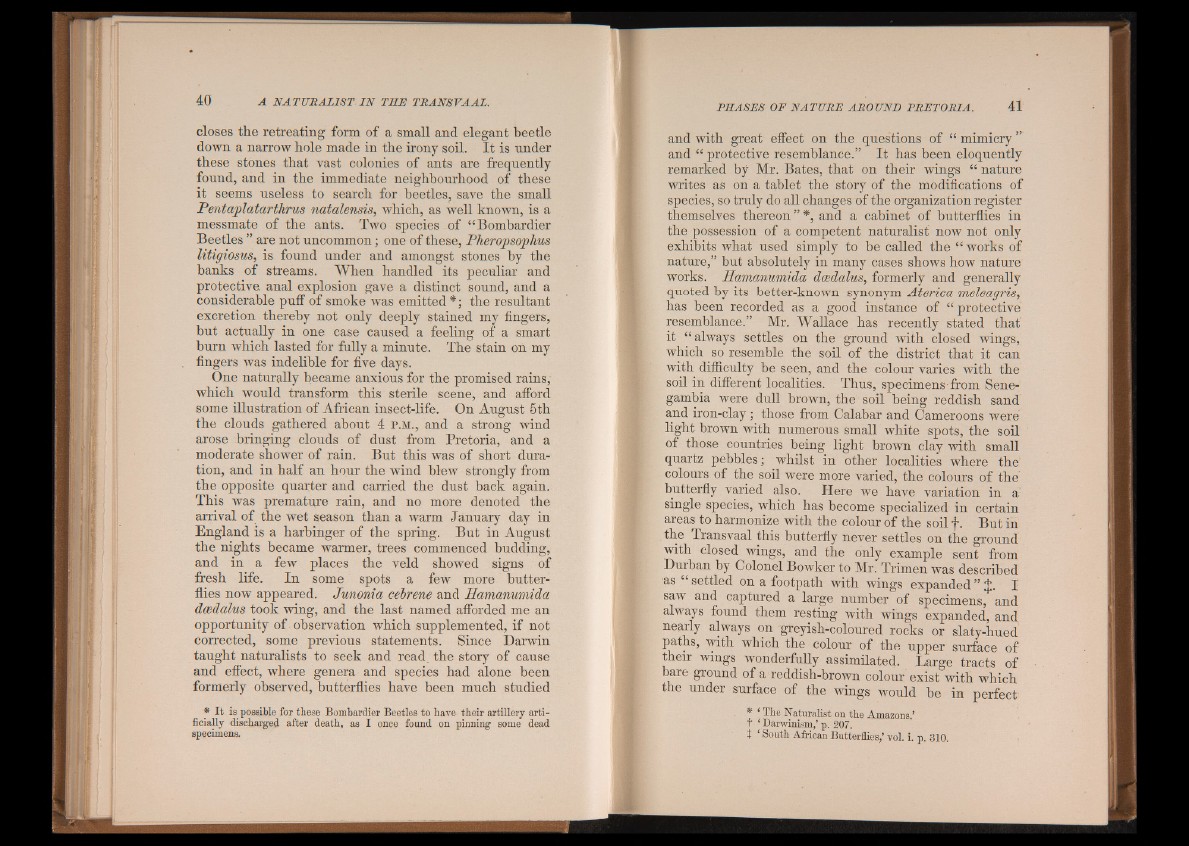
closes the retreating form of a small and elegant beetle
down a narrow hole made in the irony soil. It is under
these stones that vast colonies of ants are frequently
found, and in the immediate neighbourhood of these
it seems useless to search for beetles, save the small
Pentaplatarthrus natalensis, which, as well known, is a
messmate of the ants. Two species .of “Bombardier
Beetles ” are not uncommon; one of these, Pheropsophus
litigiosus, is found under and amongst stones by the
banks of streams. When handled its peculiar and
protective anal explosion gave a distinct sound, and a
considerable puff of smoke was emitted*; the resultant
excretion thereby not only deeply stained my fingers,
but actually in one case caused a feeling of a smart
burn which lasted for fully a minute. The stain on my
fingers was indelible for five days.
One naturally became anxious for the promised rains,'
which would transform this sterile scene, and afford
some illustration of African insect-life. On August 5th
the clouds gathered about 4 p .m., and a strong wind
arose bringing clouds of dust from Pretoria, and a
moderate shower of rain. But this was of short duration,
and in half an hour the wind blew strongly from
the opposite quarter and carried the dust back again.
This was premature rain, and no more denoted the
arrival of the wet season than a warm January day in
England is a harbinger of the spring. But in August
the nights became warmer, trees commenced budding,
and in a few places the veld showed signs of
fresh life. In some spots a few more butterflies
now appeared. Junonia cebrene and Hamanumida
dcedalus took wing, and the last named afforded me an
opportunity of observation which supplemented, if not
corrected, some previous statements. Since Darwin
taught naturalists to seek and read the story of cause
and effect, where genera and species had alone been
formerly observed, butterflies have been much studied
* It is possible for these Bombardier Beetles to have their artillery artificially
discharged after death, as I once found on pinning some dead
specimens.
and with great effect on the questions of “ mimicry ”
and “ protective resemblance.” It has been eloquently
remarked by Mr. Bates, that on their wings p nature
writes as on a tablet the story of the modifications of
species, so truly do all changes of the organization register
themselves thereon ” *, and a cabinet of butterflies in
the possession of a competent naturalist now not only
exhibits what used simply to be called the “ works of
nature,” but absolutely in many cases shows how nature
works. Hamanumida dcedalus, formerly and generally
quoted by its better-known synonym At erica meleagris,
has been recorded as a good instance of “ protective
resemblance.” Mr. Wallace has recently stated that
it “ always settles on the ground with closed wings,
which so resemble the soil of the district that it can
with difficulty be seen, and the colour varies with the
soil in different localities. Thus, specimens-from Sene-
gambia were dull brown, the soil being reddish sand
and iron-clay; those from Calabar and Oameroons were
light brown with numerous small white spots, the soil
of those countries being light brown clay with small
quartz pebbles; whilst in other localities where the
colours of the soil were more varied, the colours of the’
butterfly varied also. Here we have variation in a
single species, which has become specialized in certain
areas to harmonize with the colour of the soilf. Butin
the Transvaal this butterfly never settles on the ground
with closed wings, and the only example sent from
Durban by Colonel Bowker to Mr. Trimen was described
as settled on a footpath with wings expanded ” J. I
saw and captured a large number of specimens, and
always found them resting with wings expanded, and
nearly always on greyish-coloured rocks or slaty-hued
paths, with which the colour of the upper surface of
their wings wonderfully assimilated. Large tracts of
bare ground of a reddish-brown colour exist with which
the under surface of the wings would be in perfect:
. * ‘ The Naturalist on the Amazons.’
t ‘ Darwinism,’ p. 207.
t ‘ South African Butterflies,’ vol. i. p. 310.